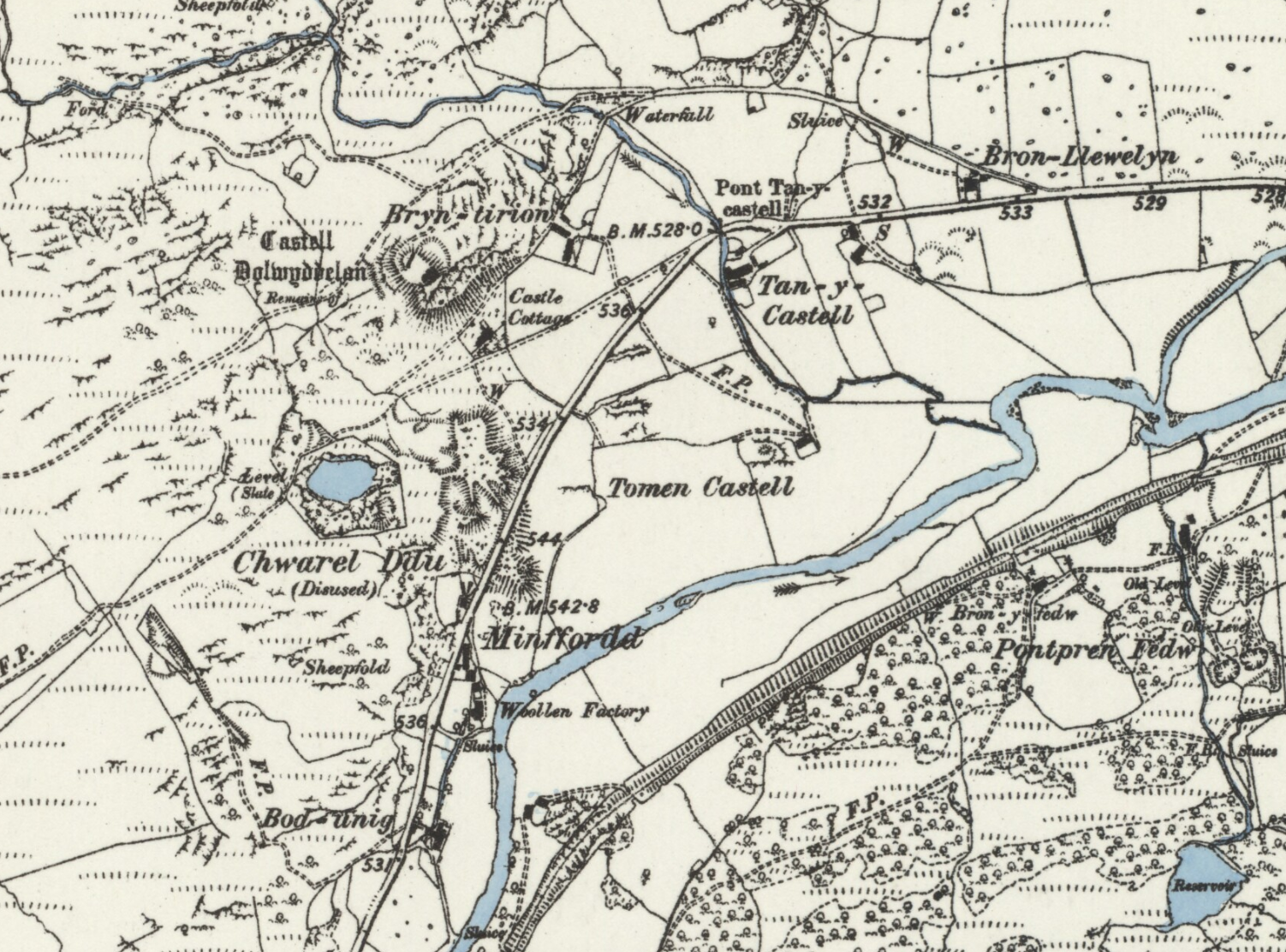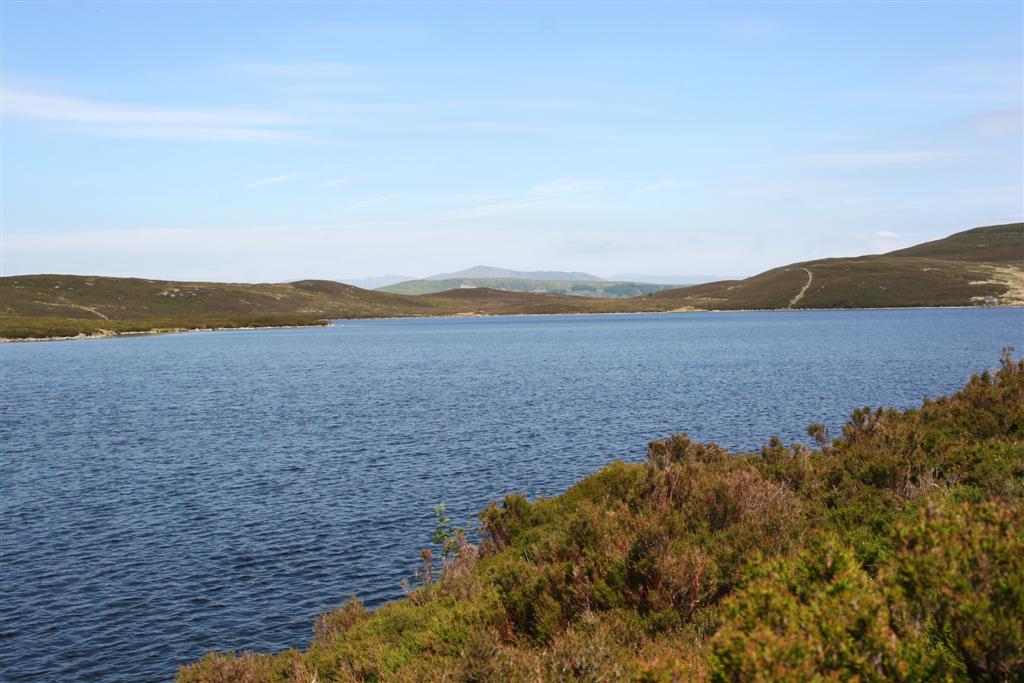|
Nod Glas
The Nod Glas Formation (also known as the Nod Glas Black Shale, the Cadnant Shale, the Penarwel Mudstones or just Nod Glas) is an Ordovician lithostratigraphic group (a sequence of rock strata) in Mid Wales. The rock of the formation is made up of pyritous, graptolitic mudstone that is generally black in colour. It weathers to a soft, very well cleaved and coal-like material. The formation runs from Conwy in the north, down to Cardigan Bay in the area around Aberdyfi and Tywyn, though it is not a continuous over this area. The formation is the topmost of the Caradoc Series in North Wales, and the name refers to all the black shale beds in the area. In South Wales, the equivalent beds of shale are called the Dicranograptus Shales. North Wales Between Tywyn and Aberllefenni the Nod Glas Formation is about thick. The section between Aberllefenni and Aberangell is the type locality for the formation. North of Corris, towards Bwlch y Groes, the formation gradually thins ... [...More Info...] [...Related Items...] OR: [Wikipedia] [Google] [Baidu] |
Afon Ddu
(Welsh for ''black river'') is the name of several rivers in Snowdonia in north-west Wales: * The largest of these flows from Llyn Cowlyd on the south-eastern edge of the Carneddau range to join the river Conwy, passing Pont Dolgarrog on the B5106 road, just south of the village of Dolgarrog. The gorge cut by the river at this point is popular for gorge walking, the river passing at this point through a Site of Special Scientific Interest for broadleaved woodland and a number of rare species of plant. * Another is a stream draining the south-eastern slopes of Drum and Foel-fras, mountains in the Carneddau mountain range. It is a tributary of Afon Dulyn, itself is a tributary of the river Conwy. * A third is a stream flowing north-west from Bwlch y Ddeufaen. It is a tributary of the Afon Llanfairfechan, joining it immediately above the village of Llanfairfechan. * A fourth is a tributary of the River Dysynni in the northern Dysynni Valley, famed for Craig y Deryn __NOTOC__ C ... [...More Info...] [...Related Items...] OR: [Wikipedia] [Google] [Baidu] |
British Geological Survey
The British Geological Survey (BGS) is a partly publicly funded body which aims to advance geoscientific knowledge of the United Kingdom landmass and its continental shelf by means of systematic surveying, monitoring and research. The BGS headquarters are in Keyworth, Nottinghamshire, England. Its other centres are located in Edinburgh, Wallingford, Cardiff and London. The current motto of the BGS is: ''Gateway to the Earth''. History and previous names The Geological Survey was founded in 1835 by the Board of Ordnance as the Ordnance Geological Survey, under Henry De la Beche. This was the world's first national geological survey. It remained a branch of the Ordnance Survey for many years. In 1965, it was merged with the Geological Museum and Overseas Geological Surveys, under the name of Institute of Geological Sciences. On 1 January 1984, the institute was renamed the British Geological Survey (and often referred to as the BGS), a name still carried today. Competenc ... [...More Info...] [...Related Items...] OR: [Wikipedia] [Google] [Baidu] |
Chwarel Ddu
Chwarel Ddu quarry was the earliest slate quarry in the Lledr Valley. It was working before 1810, and continued in sporadic operation until the late 1920s. It is about west of Dolwyddelan, just beneath Dolwyddelan Castle. History The quarry is believed to have opened between 1800 and 1805. In 1810, the quarry was successful enough that the Gwydir Estate, who owned the land on which the quarry sat, constructed a cart road from the quarry to the Holyhead Road at Conwy. This now forms part of the A470. Despite this early success, the quarry only operated for short periods over the next few decade. For several years in the late 1850s, it produced significant amounts of slate, up to 700 tones per year. At this time a stationary steam engine was used to haul rock up from the open pit. By 1888 it was once more closed. There was an attempt to re-open the quarry during the 1920s, and an oil engine was installed to replace the steam engine. A small number of quarrymen were employed, ... [...More Info...] [...Related Items...] OR: [Wikipedia] [Google] [Baidu] |
Dolwyddelan
Dolwyddelan ( ; ; ) – in Victorian times, often spelled Dolyddelen – is a village and community in Conwy county borough, Wales, on the main A470 road between Blaenau Ffestiniog and Betws-y-Coed. As a community, the population of Dolwyddelan was recorded in the 2001 Census as 427, and 55.8% of those residents could speak Welsh. The population increased to 474 in the 2011 census with the proportion of Welsh speakers falling to 50.8%. Name The spelling of the village's name has varied over the years, though there appear to be two primary spellings with two primary meanings. The common modern spelling "Dolwyddelan" is translated as "Gwyddelan's meadow", referring to Saint Gwyddelan, an Irish missionary of the 6th century, after whom the parish church is named. There is some question as to which came first, the castle or the name. Saint Gwyddelan is believed to have arrived around 600 AD. A variant of this spelling is Dolwyddelen, which was particularly used by the ... [...More Info...] [...Related Items...] OR: [Wikipedia] [Google] [Baidu] |
Lledr Valley
The Lledr Valley () is a valley in Snowdonia in north Wales. It runs from the top of the Crimea Pass, north of Blaenau Ffestiniog down to Betws-y-Coed. The A470 road follows the line of the valley, as does the railway line from Blaenau Ffestiniog to Llandudno, and within the valley there are stations at Roman Bridge, Dolwyddelan, and Pont-y-Pant. Dolwyddelan is the main settlement in the valley. The river Lledr, which gives its name to the valley, joins the River Conwy to the south of Betws-y-Coed. Industry During the Victorian period the valley was renowned for its slate quarries, which were concentrated around Dolwyddelan. These quarries worked the Nod Glas Formation, which extended across Mid and North Wales. It was primarily a bed of soft, black shale, but in the area of the Dolwyddelan syncline it was partially metamorphisised into slate. The principle quarries in the valley were: * Prince Llewellyn quarry and Chwarel Fedw * Chwarel Ddu * Ty'n-y-bryn quarry and ... [...More Info...] [...Related Items...] OR: [Wikipedia] [Google] [Baidu] |
Conwy Valley
, name_etymology = , image = Boats in River Conwy.jpg , image_size = 300 , image_caption = Boats in the river estuary at Conwy , map = , map_size = , map_caption = , pushpin_map = , pushpin_map_size = , pushpin_map_caption= , subdivision_type1 = Country , subdivision_name1 = Wales , subdivision_type2 = , subdivision_name2 = , subdivision_type3 = , subdivision_name3 = , subdivision_type4 = District , subdivision_name4 = County Borough of Conwy , subdivision_type5 = City , subdivision_name5 = Conwy , length = , width_min = , width_avg = , width_max = , depth_min = , depth_avg = , depth_max = , discharge1_location= Cwm Llanerch , discharge1_min = , discharge1_avg = , discharge1_max = , source1 = , source1_location = Migneint moor where a number of small s ... [...More Info...] [...Related Items...] OR: [Wikipedia] [Google] [Baidu] |
Glyn Ceiriog
Glyn Ceiriog is the principal settlement of the Ceiriog Valley and a community in Wrexham County Borough, north-east Wales. Glyn Ceiriog translates simply as Ceiriog Valley, though there are other villages in the valley. The village and community is technically known, in traditional Welsh naming style, as Llansantffraid Glyn Ceiriog or sometimes Llansanffraid Glyn Ceiriog, which means church of St Ffraid (the Welsh name of Saint Brigid of Kildare) in the Ceiriog Valley, but it has come to be known simply as Glyn Ceiriog, or even Glyn for short. The name Llansanffraid is now more associated with other villages of the same name. It is in the Clwyd South Senedd constituency and Clwyd South UK parliamentary constituency. A former slate mining village, it lies on the River Ceiriog and on the B4500 road, about 6 miles (10 km) west of Chirk. It is south of Llangollen. Geography and administration Civic history Glyn Ceiriog was historically administered as the civil parish ... [...More Info...] [...Related Items...] OR: [Wikipedia] [Google] [Baidu] |
Welshpool
Welshpool ( cy, Y Trallwng) is a market town and community in Powys, Wales, historically in the county of Montgomeryshire. The town is from the Wales–England border and low-lying on the River Severn; its Welsh language name ''Y Trallwng'' means "the marshy or sinking land". The community includes Cloddiau and Pool Quay. In English it was initially known as Pool but its name was changed to Welshpool in 1835 to distinguish it from the English town of Poole. The community had a population of 6,664 (as of the 2011 United Kingdom census A census of the population of the United Kingdom is taken every ten years. The 2011 census was held in all countries of the UK on 27 March 2011. It was the first UK census which could be completed online via the Internet. The Office for Nationa ...), with the town having 5,948. It contains much Georgian architecture and is just north of Powis Castle. History St Cynfelin is reputed to be the founder of two churches in the town, St Mary's a ... [...More Info...] [...Related Items...] OR: [Wikipedia] [Google] [Baidu] |
Limestone
Limestone ( calcium carbonate ) is a type of carbonate sedimentary rock which is the main source of the material lime. It is composed mostly of the minerals calcite and aragonite, which are different crystal forms of . Limestone forms when these minerals precipitate out of water containing dissolved calcium. This can take place through both biological and nonbiological processes, though biological processes, such as the accumulation of corals and shells in the sea, have likely been more important for the last 540 million years. Limestone often contains fossils which provide scientists with information on ancient environments and on the evolution of life. About 20% to 25% of sedimentary rock is carbonate rock, and most of this is limestone. The remaining carbonate rock is mostly dolomite, a closely related rock, which contains a high percentage of the mineral dolomite, . ''Magnesian limestone'' is an obsolete and poorly-defined term used variously for dolomite, for limes ... [...More Info...] [...Related Items...] OR: [Wikipedia] [Google] [Baidu] |
Dinas Mawddwy
Dinas Mawddwy () is a village in the community of Mawddwy in south-east Gwynedd, north Wales. It lies within the Snowdonia National Park, but just to the east of the main A470, and consequently many visitors pass the village by. Its population is roughly 600. The village marks the junction of the unclassified road to Llanuwchllyn which climbs up through the mountains to cross Bwlch y Groes at its highest point, the second highest road pass in Wales. This minor road also provides the closest access to the mountain Aran Fawddwy and is the nearest settlement to Craig Cywarch. Geography Dinas Mawddwy stands at the confluence of three rivers. The Afon Cywarch flows from the mountains to the north and the Afon Cerist flows from the west, both joining the River Dyfi here. The Dyfi flows south to Cemmaes Road where it turns west to head past Machynlleth to the Irish Sea. The mountains to the north are the Aran Fawddwy range of high, rocky peaks. To the south and the west stand the ... [...More Info...] [...Related Items...] OR: [Wikipedia] [Google] [Baidu] |
Bwlch Y Groes
Bwlch y Groes (translates from Welsh as ''pass of the cross'') is the second highest public road mountain pass in Wales, with a summit altitude of . Gospel Pass in south Wales is slightly higher. It lies on minor roads linking Dinas Mawddwy (via Llanymawddwy), Llanuwchllyn and Lake Vyrnwy. The view from the pass encompasses the plain of the Dyfi valley, Cadair Idris and a close view of Aran Fawddwy. The cross, just below the summit at the junction of the roads from Vyrnwy and from Dinas Mawddwy, commemorates the place of the pass on a pilgrim route from north Wales. Bwlch y Groes, known by some as ''Hellfire Pass'', was used between and after the wars by the Austin Motor Company and the Standard Triumph Motor Company to test prototype cars and their performance during hillclimbing. The British Motorcycle industry which was world beating before the wars also used the pass for testing. In 1926 BSA undertook a continual test resulting in the company being awarded by the Auto-Cycle ... [...More Info...] [...Related Items...] OR: [Wikipedia] [Google] [Baidu] |
Type Locality (geology)
Type locality, also called type area, is the locality where a particular rock type, stratigraphic unit or mineral species is first identified. If the stratigraphic unit in a locality is layered, it is called a stratotype, whereas the standard of reference for unlayered rocks is the type locality. The term is similar to the term type site in archaeology or the term type specimen in biology. Examples of geological type localities Rocks and minerals * Aragonite: Molina de Aragón, Guadalajara, Spain * Autunite: Autun, France * Benmoreite: Ben More (Mull), Scotland * Blairmorite: Blairmore, Alberta, Canada * Boninite: Bonin Islands, Japan * Comendite: Comende, San Pietro Island, Sardinia * Cummingtonite: Cummington, Massachusetts * Dunite: Dun Mountain, New Zealand. * Essexite: Essex County, Massachusetts, US * Fayalite: Horta, Fayal Island, Azores, Portugal * Harzburgite: Bad Harzburg, Germany * Icelandite: Thingmuli (Þingmúli), Iceland * Ijolite: Iivaara, Kuusamo, Finl ... [...More Info...] [...Related Items...] OR: [Wikipedia] [Google] [Baidu] |







